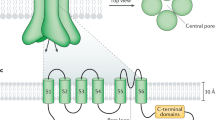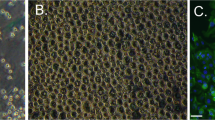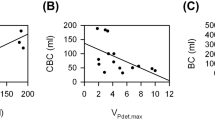Abstract
The transient receptor potential cationic channel type A1 (TRPA1), belonging to a superfamily of cationic membrane channels, has been suggested to act as mechano- and pain sensor and, thus, to play a role in neurotransmission in the human body, including the urogenital tract. While the expression of TRPA1 has been investigated in a variety of tissues, up until today, no study has addressed the expression and distribution in the female genital tract. The present study aimed to investigate the expression and distribution of TRPA1 protein in human vaginal tissue. Reverse transcriptase PCR (RT-PCR) was applied in order to identify messenger ribonuleic acid specifically encoding for TRPA/A1. The distribution of TRPA1 in relation to the neuronal nitric oxide synthase (nNOS) and the signaling peptide calcitonin gene-related peptide (CGRP) was examined by means of immunohistochemical methods (double-antibody technique, laser fluorescence microscopy). RT-PCR analysis revealed the expression of mRNA encoding sequences specific for TRPA in the vaginal wall and epithelium. Immunostaining related to TRPA1 was observed in the basal epithelium and in slender varicose nerve fibers transversing the subepithelial and stromal space of the vaginal sections. In addition, these fibers presented immunoreactivity specific for nNOS or CGRP. The smooth musculature of the vaginal wall and small vessels interspersing the tissue did not present signals related to TRPA1. The findings indicate that TRPA1 might be involved in afferent neurotransmission in the vagina and work synergistically together with the nitric oxide/cyclic guanosine monophosphate pathway.
This is a preview of subscription content, access via your institution
Access options
Subscribe to this journal
Receive 8 print issues and online access
$259.00 per year
only $32.38 per issue
Buy this article
- Purchase on Springer Link
- Instant access to full article PDF
Prices may be subject to local taxes which are calculated during checkout


Similar content being viewed by others
References
Munarriz R, Kim SW, Kim NN, Traish A, Goldstein I . A review of the physiology and pharmacology of peripheral (vaginal and clitoral) female genital arousal in the animal model. J Urol 2003; 170: S40–S45.
Burnett AL, Truss MC . Mediators of the female sexual response; pharmaco-therapeutic implications. World J Urol 2002; 20: 101–105.
Park K, Goldstein I, Andry C, Siroky MB, Azadzoi KM . Vasculogenic female sexual dysfunction: the hemodynamic basis for vaginal engorgement insufficiency and clitoral erectile insufficiency. Int J Impot Res 1997; 9: 27–37.
Berman JR, Bassuk J . Physiology and pathophysiology of female sexual function and dysfunction. World J Urol 2002; 20: 111–118.
Nilius B, Owsianik G, Voets T, Peter JA . Transient receptor potential cation channels in disease. Physiol Rev 2007; 87: 165–217.
Anand U, Otto WR, Facer P, Zebda N, Selmer I, Gunthorpe MJ et al. TRPA1 receptor localisation in the human peripheral nervous system and functional studies in cultured human and rat sensory neurons. Neurosci Lett 2008; 438: 221–227.
Salas MM, Hargreaves KM, Akopian AN . TRPA1-mediated responses in trigeminal sensory neurons: interaction between TRPA1 and TRPV1. Eur J Neurosci 2009; 29: 1568–1578.
Corey DP, Garcia-Anoveros J, Holt JR, Kwan KY, Lin SY, Vollrath MA et al. TRPA1 is a candidate for the mechanosensitive transduction channel of vertebrate hair cells. Nature 2004; 432: 723–730.
Everaerts W, Gevaert T, Nilius B, de Ridder D . On the origin of bladder sensing: TR(i)Ps in urology. Neurourol Urodyn 2008; 27: 264–273.
Du S, Araki I, Kobayashi H, Zakoji H, Sawada N, Takeda M . Differential expression profile of cold (TRPA1) and cool (TRPM8) receptors in human urogenital organs. Urology 2008; 72: 450–455.
Gratzke C, Streng T, Waldkirch E, Sigl K, Stief C, Andersson KE et al. Transient receptor potential A1 (TRPA1) activity in the human urethra—evidence for a functional role for TRPA1 in the outflow region. Eur Urol 2009; 55: 696–704.
Weinhold P, Gratzke C, Streng T, Stief CG, Andersson KE, Hedlund P . TRPA1 receptor induced relaxation of the human urethra involves TRPV1 and cannabinoid receptor mediated signals, and cyclooxygenase activation. J Urol 2010; 183: 2070–2076.
Hicks GA . TRP channels as therapeutic targets: hot property, or time to cool down? Neurogastroenterol Motil 2006; 18: 590–594.
Avelino A, Cruz F . TRPV1 (vanilloid receptor) in the urinary tract: expression, function and clinical applications. Naunyn Schmiedeberg’s Arch Pharmacol 2006; 373: 287–299.
Birder LA . TRPs in bladder diseases. Biochim Biophys Acta 2007; 1772: 879–884.
Cruz CD, Charrua A, Vieira E, Valente J, Avelino A, Cruz F . Intrathecal delivery of resiniferatoxin (RTX) reduces detrusor overactivity and spinal expression of TRPV1 in spinal cord injured animals. Exp Neurol 2008; 214: 301–308.
Ückert S, Waldkirch ES, Sonnenberg JE, Boeck N, Kuczyk MA, Hedlund P . Expression and distribution of the transient receptor potential ion channel A1 (TRPA1) in human penile erectile tissue. J Sex Med 2011; 8 (Suppl 5): 378, Abstract, presented the 14th Congress of the European Society for Sexual Medicine, Milano, Italy, 01-Dec to 04-Dec-2011.
Ückert S, Simon A, Sonnenberg JE, Merseburger AS, Kuczyk MA, Hedlund P . Expression of the transient receptor potential cationic channel A1 (TRPA1) in the human seminal vesicles - an immunohistochemical and molecular biology study. Eur Urol Suppl 2013; 12 (No. 1): e329, Abstract, presented at the 28th Congress of the European Association of Urology, Milano, Italy, 15-March to 19-March-2013.
Streng T, Axelsson HE, Hedlund P, Andersson DA, Jordt SE, Bevan S et al. Distribution and function of the hydrogen sulfide-sensitive TRPA1 ion channel in rat urinary bladder. Eur Urol 2008; 53: 391–399.
Gratzke C, Weinhold P, Reich O, Seitz M, Schlenker B, Stief CG et al. Transient receptor potential A1 and cannabinoid receptor activity in human normal and hyperplastic prostate: relation to nerves and interstitial cells. Eur Urol 2010; 57: 902–909.
Andrade EL, Ferreira J, André E, Calixto JB . Contractile mechanisms coupled to TRPA1 receptor activation in rat urinary bladder. Biochem Pharmacol 2006; 72: 104–114.
Author information
Authors and Affiliations
Corresponding author
Ethics declarations
Competing interests
The authors declare no conflict of interest.
Rights and permissions
About this article
Cite this article
Ückert, S., Sonnenberg, J., Albrecht, K. et al. Expression and distribution of the transient receptor potential cationic channel ankyrin 1 (TRPA1) in the human vagina. Int J Impot Res 27, 16–19 (2015). https://doi.org/10.1038/ijir.2014.23
Received:
Revised:
Accepted:
Published:
Issue Date:
DOI: https://doi.org/10.1038/ijir.2014.23
This article is cited by
-
Exploration of Ion Channels in the Clitoris: a Review
Current Sexual Health Reports (2019)
-
Expression and distribution of the transient receptor potential cationic channel A1 (TRPA1) in the human clitoris—comparison to male penile erectile tissue
International Journal of Impotence Research (2017)
-
Redox-sensitive transient receptor potential channels in oxygen sensing and adaptation
Pflügers Archiv - European Journal of Physiology (2016)



